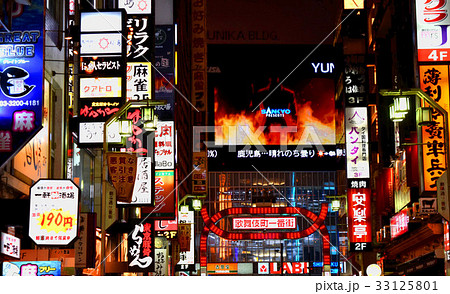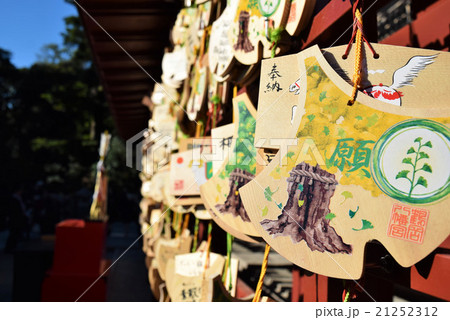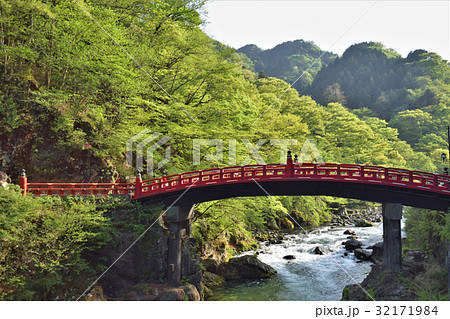だるま ~ Make My Wish Come True! ~
Are you wondering what to bring for friends as souvenirs from Japan?
だるま ( daruma ) can be an option.
A daruma is a doll, without arms or legs, with a round body and a predominating face painted on it.
It has strong features; bold eyebrows, a fine beard, and fastened lips.
They are typically red but various other colors also appear these day for a variety of wishes.
This is a wish doll.
It is considered a bringer of good luck never failing to get up even when you knock it over. A daruma is one of 張子細工 (Harikozaiku or 'papier-mache' ) which is a skeleton frame work of wood or bamboo covered by paper. The bottom is heavy, so it will get up even if it falls.
The eyes of a daruma are not painted. You have to paint them yourself.
You paint it on its left (from your right) when you wish, and paint its right (from your left) when the dream comes true.
Additionally, the Japanese eyes were originally black and what we drew it in was India ink, so I've never seen daruma's eyes a different color to black, however, there's no rule for it.
The Japanese are familiar with だるま even not as a doll.
Some games for children are used name of daruma such as だるまさんが転んだ ( darumasan-ga-koronda), and だるま落とし ( daruma-otoshi )

----------------------------------------------------------------------------------------------------------------------
日本からのお土産として何を持って行こうか、お考え中ですか。
だるまは一つの案かもしれません。
だるまとは、手足の無く、丸い体に大きな顔の描かれた人形です。
濃い特徴があります;大胆な眉毛、立派な髭と、閉じた口
典型的には赤色をしていますが、現在では様々な色のものが多様な願いのためにあります。
願いを叶える人形なのです。
倒されても、必ず起き上がる、縁起物と考えられています。
だるまは張子細工の一つで、木や竹の骨組みを紙で覆ったものです。
底は重く作られ、倒れても起き上がるようになっています。
だるまの目は描かれていません。あなたが描かなければなりません。
だるまの左目(あなたから見て右側)を願い事をする時に描き、だるまの右目(あなたから見て左側)はその願いが叶った時に描きます。
補足すると、日本人の目は元来「黒」であり、墨汁を使用して書いていたため、私は黒以外のだるまの目は見たことは無いですが、決まりはありません。
日本人は人形として、だけではなく、だるまに親しんでいます。
子供の遊びにも、だるまの名前は使われているのです。
例えば、「だるまさんが転んだ」や「だるま落とし」があります。
歌舞伎町 ~The Place I Hate the Most ~
Oh my gosh! I hate this place - 歌舞伎町 (Kabukicho).
It's infamous for its red light district and is one of the most dangerous places in Japan.
However this place full of desires fascinates many people and draws them in every day, every night.
The buzz, the harsh lighting, the vulgar places, the signs with brash color and provocative words...
Everything there looks cheap and tacky. Nothing there can be beautiful.
If someone raised in Kyoto or Paris where everything is organized, sophisticated
and beautiful saw it, they would be too shocked to say a word.
But I myself am sometimes strongly fascinated by these places where chaotic and disorganized, or to put it another way, these ugly and not posh places and they arouse my curiosity.
Though at the same time, I hate them in spite of this.
One day I remembered a word 憎愛 (zouai) which consists of the characters 憎 (hatred) and 愛 (love).
It shows literally the feelings of hatred combined with love .
It's because you love it, you hate it as well.
Perhaps the mixture of conflicting feelings deepen my attachment.
I feel the same thing for other places, persons and my country as well.
Well...at the end of the day, perhaps, it's just because I may not be that refined after all...
----------------------------------------------------------------------------------------------------------------------
あーもう、信じられない! 歌舞伎町って大っ嫌い。
風俗街や日本ではかなり危ないところ、として悪名高い場所。
そうは言っても、この欲望に満ちた場所は、毎日、毎晩、人々を引き寄せ、魅了する。
騒音、ギラギラした明かり、品の無い場所に、ドギツイ色と挑発的な言葉の看板…
どれをとっても安っぽくて、品がない。美しいものなんて一つも無い。
もしも、京都やパリのように、整い、洗練され、美しい場所で育った人が歌舞伎町を見たら、開いた口が塞がらないだろう。
しかし、時々私自身もこういった無秩序で雑多な場所、言い換えれば、気取らず、かっこ悪い場所に、強く興味をそそられてしまう。それが同時にとても不快なのにも関わらず。
ある日、「憎愛」という言葉を思い出した。
この言葉は「憎しみ」と「愛」という言葉から成り立つ。
文字通り、憎しみと愛が混ざり合う感情を表す。
愛するが故に、憎みもするのだ。
もしかしたら、この相反する感情の混じり合いが、愛着を深めるのかもしれない。
同じことを、他の場所、人や日本に対しても感じるのだから。
あー、もしかしたら、結局のところ私がそんなに洗練されていないせい、かもしれないけれども…
絵馬 ~ A Picture of a Tablet of Horses ~
Don't forget to pray when you visit a Shinto shrine!
There are tablets hanging on boards or strings and spread on a frame.
Those are called 絵馬 (ema).
We write a wish on one side of the tablet, and if you turn it over, you see a picture.
This is one way of making a wish in a shrine.
Why are they called that? ; 絵 ( picture ), 馬 ( horse).
In ancient times, the weather was important for the Japanese, an agricultural people.
And the horse was regarded as an animal ridden by gods.
So people believed that if they offered horses to 貴船神社 ( Kifune-jinja or 'Kifune shrine') dedicated to gods of water, the horses would bring the gods to the earth ,and they would have good weather.
They offered black horses when they had a long drought, and white or red horses when they had a long spell of rainy weather.
Later, they gave wooden plaques with pictures of horses, instead of real horses, due to financial reasons of the contributors, and to save the shrine the trouble of keeping horses.
And the fact that ema are pentagon shaped, like houses, is a traces of how it imitated the roof of horse stables.
Variously designed paintings appear these days for a variety of wishes.
----------------------------------------------------------------------------------------------------------------------
神社を訪れる際にはお祈りを忘れないでください。
書き板が枠に張られた棒や糸にかけられています。
これらを絵馬と呼びます。
絵馬には願い事を片面に書ます。それを裏返すと反対の面には絵が描かれています。
これは神社で祈願するための一つの方法なのです。
ではなぜ「絵馬」と呼ばれているのでしょうか。
昔、農耕民族である日本人にとって天気は大切なものでした。
そして、馬は神様が乗る動物とされていました。
そのため、人々は水の神を祀る貴船神社に馬を奉納することで、その馬が神を地上に連れてきて、良い天候に恵まれると考えていました。
日照りの際には黒い馬を、長雨の際には白もしくは赤の馬を寄進しました。
後に、寄進者側の経済的な理由と神社の馬の世話の軽減を理由に、馬の絵の描かれた飾り板を奉納するようになりました。
絵馬が家のような五角形をしているのは、馬屋の屋根を模した名残りです。
今日では多様な祈願のために、様々なデザインが描かれたものが登場しています。
Hashi ~ My Favorite Word ~
Do you know what Hashi means?
Perhaps it's written as 橋 ( bridge ) or 箸 ( chopsticks ).
Nowadays it has different characters and accents.
The sound of Hashi originally meant "connection".
橋ーBridge is a connection from one bank to another.
箸ーChopsticks were originally used for praying to gods.
It was a connection between gods and men.
As time went by, the pair of sticks were used for eating.
This was considered a blessing from gods, and so the sticks are called 箸 these days.
Newly married couples are often gifted two pairs of 箸 called 夫婦箸 (
These days, most Japanese people don't know the origin of the word Hashi.
----------------------------------------------------------------------------------------------------------------------
「はし」という言葉の意味をご存じでしょうか。
もしかしたら、それは「橋」や「箸」と書かれているかもしれません。
「はし」には現在、異なる文字とアクセントがあります。
そもそもは「はし」という音に「繋がり」という意味がありました。
橋は、対岸を結ぶもの。
箸は、もともと神に祈りを捧げるためのものでした。
時が経ち、対の棒が食事に使われるようになりました。すなわち、神の恵みを受けることに用いられたのです。これを現在、箸と呼んでいます。
新婚のカップルは2膳の箸を贈られることがあります。これは夫婦箸と呼ばれています。
現在、多くの日本人は「はし」の由縁を知りません。
しかし、この言葉を使用することによって繋がりを築こうとしているのです。




